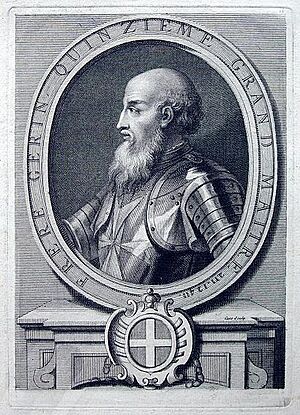Guérin de Montaigu facts for kids
Guérin de Montaigu (died 1228) was an important leader of the Knights Hospitaller. He was the 14th Grand Master of this famous knightly order, serving from 1207 to 1228. He took over after Grand Master Geoffroy le Rat passed away.
Contents
About Guérin de Montaigu
Guérin de Montaigu became the Grand Master in the summer of 1207. Before this, he was a Marshal, a high-ranking officer, in the Hospitaller Order. He also took part in the Fifth Crusade, a major military campaign.
He died peacefully between late 1227 and early 1228 while helping to rebuild the walls of Sidon. People at the time said he was one of the greatest leaders the Hospitallers ever had.
It's believed that Guérin came from a noble family in Auvergne, France. Some traditions say he was the brother of Pierre de Montaigu, who was the Grand Master of the Knights Templar (another famous knightly order) from 1219 to 1232. However, old family records don't clearly show this connection.
Conflicts in Antioch
Guérin de Montaigu, like the Grand Masters before him, got involved in a big conflict in the Principality of Antioch. This was a dispute over who should rule Antioch after its leader, Bohémond III, died.
Bohémond III wanted his grandson, Raymond-Roupen, to be the next ruler. But his second son, Bohémond IV, who was also the Count of Tripoli, disagreed and took control of Antioch.
The Knights Templar supported Bohémond IV. But the Hospitallers, led by Guérin, sided with Raymond-Roupen and his great-uncle, King Leo I of Armenia. This led to a long and difficult fight.
The Pope tried to stop the fighting, sending people to mediate, but it didn't work. King Leo I even took over Antioch for a short time, putting Raymond-Roupen in charge. But Bohémond IV soon took it back.
The Pope's Intervention
Bohémond IV was very angry with the Hospitallers. He took back their castle in Antioch and caused problems for their lands in Tripoli.
Pope Honorius III and later Pope Gregory IX stepped in to help the Hospitallers. Pope Gregory IX even excommunicated Bohémond IV in 1230. This meant Bohémond IV was cut off from the Church.
Finally, in 1231, a peace treaty was signed between Bohémond IV and the Hospitallers. Bohémond agreed to give the Hospitallers back their rights and lands. In return, the Pope lifted the excommunication.
Gaining New Lands
Because the Hospitallers were so loyal during the conflict in Antioch, they were rewarded with more land and property.
In the Holy Land
Guérin de Montaigu received several important places for the Hospitallers. These included:
- Gibelacar in 1207.
- Château de la Vieille in 1210.
- An income from Gédéide in 1216.
- Selefkeh, Chastel Neuf, and Çamardı in 1210. These lands helped the Hospitallers defend against the Seljuk Turks.
They also gained lands in the County of Jaffa, the County of Edessa, and the County of Tripoli. They received income from places like Gibelet and castles like Berzaal. On the island of Cyprus, Hugh I of Cyprus gave them many lands and special rights.
In Europe
The Hospitallers also received many gifts and lands in Europe.
- Andrew II of Hungary was very generous to them.
- Nobles in Carinthia, Styria, and other parts of Germany gave them towns and lands.
- In France, the Duke of Burgundy and other counts and viscounts also donated lands and houses to the Order. These donations helped support the Hospitallers' work in the Holy Land.
The Fifth Crusade
The Fifth Crusade began in 1217. The first group of Crusaders arrived at Acre. Guérin de Montaigu helped bring important leaders like Leopold VI of Austria and Andrew II of Hungary to Cyprus.
A war council was held in Acre to decide what to do. The Crusaders tried to attack Mount Tabor and laid siege to Sidon, but these efforts didn't achieve much. Many Crusaders, including the King of Hungary, soon returned home.
Expedition to Egypt
New Crusaders arrived from Europe, and the fight continued. With the help of the Hospitallers and Templars, they strengthened fortifications in Caesarea.
Then, the Crusaders decided to attack Egypt. They sailed to Damietta in June 1218 and began a siege. During a battle in 1219, the Hospitaller Marshal, Aymar de Lairon, and many of his knights were killed.
The city of Damietta was finally captured in November 1219. However, the Crusaders found themselves in a difficult position. In August 1221, they had to negotiate with the Muslims to leave Damietta and return to Acre. This marked the end of the Fifth Crusade, which ultimately failed.
Journeys to Europe
In 1222, Emperor Frederick II invited leaders from the Holy Land to meet him. Guérin de Montaigu traveled to Italy with the King of Jerusalem and other important figures.
They met the Pope in Rome and then Frederick II in Ferentino. Frederick promised to go on a Crusade in 1225. After this, Guérin de Montaigu and the King of Jerusalem traveled to France and England to ask for help, but they didn't get much support.
Guérin then continued his journey, visiting cities like Bordeaux and Paris, before returning to the Hospitaller headquarters.
Later Years
In his later years, Guérin de Montaigu helped Christians in Armenia against their enemies. He also helped defend Acre from the Sultan of Damascus.
He tried to make peace between the Hospitallers and the Templars, but it was difficult. In 1228, he convinced Pope Gregory IX to break a truce with the Muslim powers. However, he refused to serve in the army led by Frederick II, who had been excommunicated by the Pope.
Guérin de Montaigu died in Palestine in 1228. He was succeeded as Grand Master by Bertrand de Thessy.
See also
 In Spanish: Guarino de Montaigú para niños
In Spanish: Guarino de Montaigú para niños
- Cartulaire général de l'Ordre des Hospitaliers
- List of Knights Hospitaller sites
- Langue (Knights Hospitaller)
- Flags of the Knights Hospitaller


